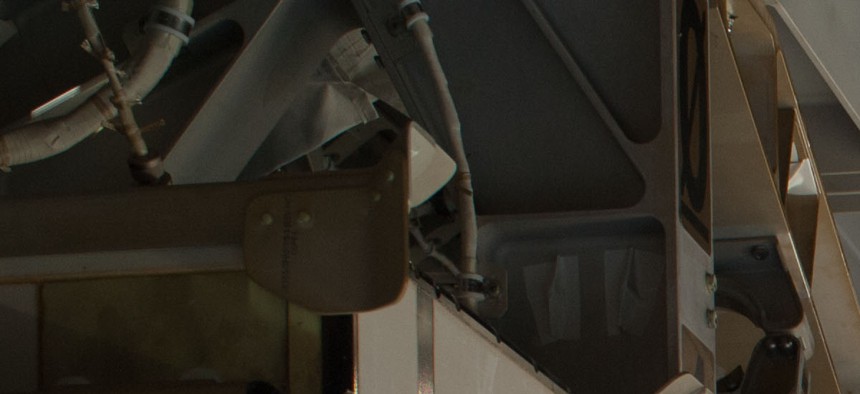Sending Astronauts to Space Is Worth It -- If the Goal Is Mars

Astronaut Steve Swanson is pictured during a spacewalk on the International Space Station. NASA/AP
But we’ll have to increase NASA’s budget and cooperate with China, report concludes.
After weighing the costs and dangers of human spaceflight against concerns such as national security and “the eventual survival of the human species through off-Earth settlement,” a congressionally mandated report concludes the United States should go for it -- but only under certain conditions.
NASA’s human spaceflight program must take a disciplined and incremental approach toward the “horizon goal” of putting humans on Mars, the National Research Council’s Human Space Flight Committee said in a report released Wednesday.
This “pathway” approach would involve specific intermediate accomplishments and destinations -- which may include the moon, an asteroid and perhaps Martian moons -- with a clear eye toward the surface of Mars itself.
“Among this small set of plausible goals, the most distant and difficult is putting human boots on the surface of Mars, thus that is the horizon goal for human space exploration,” said Jonathan Lunine, director of the Center for Radiophysics and Space Research at Cornell University and co-chair of the committee that wrote the report. “All long-range space programs by our potential partners converge on this goal.”
Indeed, the program’s success will require international cooperation -- almost certainly including with China. “Current federal law preventing NASA from participating in bilateral activities with the Chinese serves only to hinder U.S. ability to bring China into its sphere of international partnerships and reduces substantially the potential international capability that might be pooled to reach Mars,” the report said.
The program also will require a more reliable stream of greater amounts of money. “A program of human space exploration beyond low Earth orbit that satisfies the pathway principles . . . is not sustainable with a budget that increases only enough to keep pace with inflation,” the report said.
Howard McCurdy, an American University professor with expertise in space policy who did not help author the report, said money has been a missing element in discussions of recent human spaceflight programs. “I’m glad they’re focusing on the financing,” he said. “NASA can’t do this within it’s current tax-financed discretionary budget profile, but that doesn’t mean there's not another alternative -- there are other alternatives.”
McCurdy offered the possibility of private-sector funding or participation, as well as international cooperation: "The big issue is the heavy-lift launch vehicle: who can do that cheaper?"
NASA’s human spaceflight program has in the last decade been at the whim of sharp policy shifts and funding constraints. The agency’s science programs at least have the continuity of decadal studies, with recommended priorities coming from the scientific community. In the absence of a clear path toward a long-term goal, NASA retired its space shuttle program in 2011 without an immediate successor. U.S. astronauts now rely on Russian rides to the International Space Station -- a taxi service the private-sector is looking to take over. “A national consensus on the long-term future of human spaceflight beyond our commitment to the ISS remains elusive,” the report noted.
NASA itself appeared more sure of its human spaceflight future, welcoming the report as validation of the plan the agency said it has been implementing since 2010 -- when the study was requested. “There is a consensus that our horizon goal should be a human mission to Mars and the stepping stone and pathways thrust of the NRC report complements NASA’s ongoing approach,” the agency said in a statement responding to the report. “NASA has made significant progress on many key elements that will be needed to reach Mars, and we continue on this path in collaboration with industry and other nations.”
The report was required by the 2010 NASA Authorization Act to review “the goals, core capabilities and direction of human spaceflight.” In addition to the usual lot of astrophysicists and engineers, the committee also sought perspectives from sociologists, historians and a scholar of African American studies on the rationale behind human space flight and the public good it might provide.
While NASA has been justifying space exploration for decades, the arguments that held in the early days aren’t necessarily relevant in 2014. Competition with the Soviet Union fueled the Apollo program, which put men on the moon in 1969. “The arguments that triggered the Apollo investments, national defense and prestige, seem to have especially limited public salience in today’s post-Cold War America,” the report said.
The committee considered a handful of other rationales, including practical benefits, such as the inspiration human spaceflight would provide U.S. students and the economic benefits of earthly applications of scientific advances.
Then there were the aspirational considerations about species survival and the human need to explore: “It is not possible to say whether off-Earth settlements could eventually be developed that would outlive human presence on Earth and lengthen the survival of our species. This is a question that can only be settled by pushing the human frontier in space,” the report said.
The committee concluded that while no one argument justified the expense and health risks of human spaceflight, the aspirational rationales coupled with the practical benefits the program could provide do ultimately make it worthwhile.
“Some say it is human destiny to continue to explore space. While not all share this view, for those who do, it is an important reason to engage in human spaceflight,” the report said.






